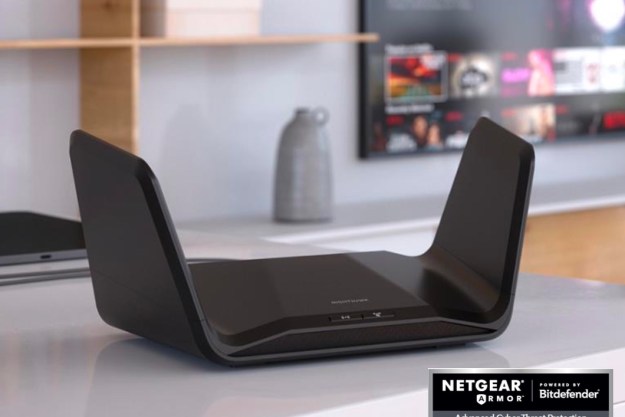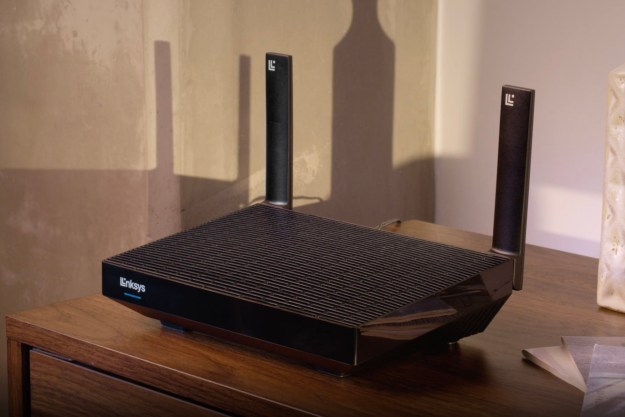Wireless routers are everywhere. Nearly every house, apartment, business, and sketchy van parked down by the river has one. A functional wireless router allows you to easily connect your computer to a broadband internet service so you can share data files and stream media between mobile/Wi-Fi devices.
Although you could opt for a wired router, we suggest a wireless model so you can avoid stringing Ethernet cable around your home. Besides, a wireless router is the best way to access the internet using your smartphone or tablet. And if you ever discover you absolutely must have a wired connection, the router will have a built-in switch to handle it. While you’re at it, check out the best routers currently on the market, along with our guide on how to secure your wireless network.
Choosing the right Wi-Fi standard
Digital Trends Wi-Fi router guide
- Best routers for small businesses
- How to set up a Wi-Fi router
- How to tell if someone is stealing your Wi-Fi
- Top Wi-Fi router reviews
Just like smartphones, router manufacturers are constantly implementing new and more powerful wireless standards (IEEE protocols) as technology becomes more advanced. That’s why we have standards like 802.11g, 802.11n, and 802.11ac — these aren’t just random numbers, they are a description of router capabilities.
The latest standard is 802.11ax, now more popularly known as Wi-Fi 6. New routers will be Wi-Fi 6 compatible, and the latest rounds of smartphones and other mobile devices will launch with Wi-Fi 6 compatibility. This new version adds a slew of updates and reworked protocols to help improve speed, reliability, and security, and it even helps you extend device battery life. It also has features like MU-MIMO, which can increase network performance for specific mobile devices with a dedicated connection.
If you’re buying a new router, it’s particularly important to look for Wi-Fi 6 routers right now, even if you don’t have a lot of devices that are Wi-Fi 6 compatible. Otherwise, your router will quickly become obsolete long before its expected lifespan comes to an end.
Interpreting Wi-Fi network speeds
Remember, you should always take manufacturers’ speed declarations with a grain of salt. For example, many manufacturers list “theoretical” maximum bandwidth on their boxes. You’ll see anything from 350Mb/sec to 3,500Mb/sec (megabits per second), but you’ll rarely see throughput that high in realistic environments in which walls, doors, appliances, and other barriers separate your router from its client devices.
All wireless routers feature built-in Ethernet for hard-wired network connections, but cheaper routers will have switches rated at only 100Mb/sec. You won’t regret spending a few extra dollars to buy a model with a Gigabit switch (that’s 1,000Mb/sec).
Deciding how many bands you need
Manufacturers have sold dual-band routers for years, but now many are starting to roll out tri-band routers as well.
Dual-band typically means the router is equipped with two radios, one that operates on the 2.4GHz frequency band, and one that runs on the 5GHz frequency band. This enables you to set up two separate wireless networks, so you can improve speeds in a crowded wireless network by bumping some devices over to the alternate frequency. This can also help if there’s potential interference in the 2.4GHz band like microwaves and Bluetooth devices.
In addition to switching to channels with less “noise,” it’s important to note that the 2.4GHz band does have a broader range even if its speeds may not be the best. The 5GHz band has a shorter range and works best with nearby devices.
Make sure you read the fine print, though. Some dual-band routers in fact have one radio that can operate on either the 2.4GHz or 5GHz bands, but not both at the same time. Tri-band routers include a second 5GHz band. This is helpful if you have a lot of mobile devices on one network and need to spread them around three bands for greater efficiency and data management. Tri-band routers remain rare, because very few people need them. They can be useful in a dorm or office but aren’t necessary for the average house.
Managing Wi-Fi security

Wireless networks are as insecure as they are convenient — if you don’t take steps to secure your network, just about any troublemaker within range can eavesdrop on your online activities, leech off your internet connection, access any of the files stored on your computers, infect your systems with viruses, and cause all sorts of other problems.
Any router you buy should support at least WPA2 (the second implementation of the Wi-Fi Protected Access protocol), but today many devices come with WPA3, which provides even more robust security, so use WPA3 whenever possible and WPA2 only as a fallback. Remember, in general, your network is only as secure as the lowest level of security on any connected device.
Also keep in mind that some routers are designed with enterprise or advanced family security in mind. These devices come with many extra features, including the ability to add extra encryption, monitor devices, block unwanted users from the network, and even see what people are browsing.
Smart wireless management
One of the worst problems to plague the average router is interference. A router isn’t much good if it can’t give you acceptable wireless signals everywhere you want it. Fortunately, most modern routers have a couple other tricks to deal with this problem.
The solution is using “smart” processes that identify devices or dead zones and target them with Wi-Fi signals so they always get service. The monstrous D-Link AC3200 Ultra, for example, has SmartBeam technology to do just this. Products like Luma, on the other, encourage people to buy several routers and link them together to create a Wi-Fi web around your home that eliminates dead zones. These solutions are something to keep in mind if you’ve had bad experiences with routers in the past.
Google Wi-Fi goes a step further, baking extensive Wi-Fi functionality into an easily understood smartphone app. Other manufacturers are also taking this route, though Google’s remains a high point among the competition.
Additionally, many routers these days are coming out with voice assistant technology, compatibility with Alexa and other VAs so you can control them with your voice. This may have limited application for now, but you can use voice commands to switch modes or add guests, which may be handy. Parents might find voice commands even more useful, since a simple, “Alexa, remove Timmy’s smartphone from the Wi-Fi network” will ensure that someone focuses on their homework.
Finally, note that the more automatic and security functions that a router has, the harder it has to work. Routers with lots of features should also have multi-core processors to manage everything while still enabling expected speeds.
Do you need a mesh network?

A mesh network is made of several router devices that are designed to work together, overlap their signals, and create a single dependable network. Mesh networks have grown in popularity over the past few years, as seen with models like Google Wi-Fi.
Mesh networks tend to have all the same features as regular routers, although they may have lower speeds than others in their price range (this matters less when you have three different routers working together, but is still worth noting). They are particularly useful in two cases. First, if you live in a smaller space like an apartment, you may be able to buy just one mesh router at a low price and use it like a traditional router. Second, if you have a large home (say, 3,000 square feet or over) and you have struggled with wireless connectivity in the past, a mesh network is the ideal solution for your large space, and is likely to work better than a single traditional router.
Routers and gaming

The ideal online connection for gaming will always be a wired Ethernet cable, as it offers the best performance and stability. But that’s not always possible for consoles in hard-to-reach places or mobile games that are meant to be played on the move.
The good news is that your router may be able to help. Some routers come with dedicated gaming features that will specifically prioritize packets of data heading to games and connections with gaming servers. If that’s something that interests you, look for models like the Asus ROG Rapture GT-AX11000 to make the most of your wireless connection when gaming.
Why you don’t rent a router

Are you setting up internet service with a new provider? What you buy compared to what devices you rent can grow confusing. Many people choose to rent the modem itself (although this is not necessary, as you can buy your own modem to save money over time), but purchase their own Wi-Fi router to connect to the modem.
In the past, providers like Frontier have taken advantage of customer confusion around these arrangements and charged leasing fees for routers that they weren’t providing. As of December 2020, there is a law explicitly banning this practice: If you bought your router, you cannot be charged a monthly fee for it as part of your plan.
Ultimately, the one and only exception to this law is if you are clearly renting a router, typically with a modem-router combination you acquired straight from your internet provider. Still, this limits your ability to update your router to more current standards when needed, which is why it’s a better idea to spend some money and purchase your own router—which you can also carry with you if you relocate in the next upcoming years.
What to spend: Price vs. performance
Router rates fluctuate significantly based on their features, antennas, ports, and countless other factors. Commonly, the most reliable routers available now range from $100 to $250 or more. You can obtain smaller routers under this price and large enterprise routers above it, but most of them settle someplace along the border. If you’re someone who is working with a tighter budget, you can find some decent routers for $50 or less, but understand that they won’t give you all the newest and best features. If these aren’t impressive enough for you, it’s always a good idea to take a look at all the best Black Friday router deals.
An inexpensive router that offers a mediocre performance is not a good deal. Product reviews will clue you in on what you can expect, but installing one in your own home is the only surefire way to discern how the router will work in your unique setting. When you get your router, be sure that the seller you’re dealing with gives you a generous return policy if you’re not satisfied with the product.
Editors' Recommendations
- How to change your router’s Wi-Fi password
- Here’s how to choose the right printer to buy in 2024
- How to buy a gaming PC for the best performance and value
- A beginner’s guide to Tor: How to navigate the underground internet
- What is Wi-Fi 7: Everything you need to know about 802.11be





